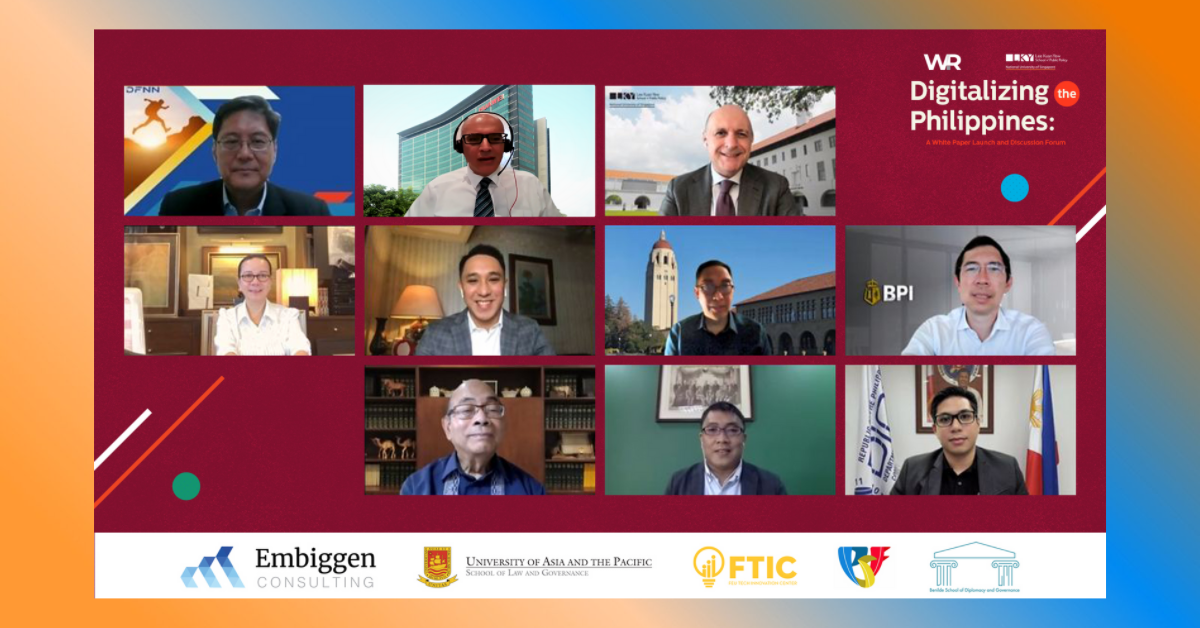During the onset of the ongoing pandemic, many businesses — both big and small — said that they realized the importance of digitalization as something crucial to economic growth and recovery. Indeed, around the globe, digitalization has helped governments, schools, and businesses shift to what would soon be the new normal.
Here in the Philippines, digital technology ensures better governance, improves the quality and reach of eLearning, and creates and/or retains jobs and industries. It could also aid pandemic response by facilitating safety protocols, vaccine rollouts, and accessible health and non-health services to curb COVID-19 cases.
During the recently held white paper launch and discussion forum “Digitalizing the Philippines” organized by public affairs and strategy firm W&R and the National University of Singapore’s Lee Kuan Yew School of Public Policy (NUS-LKY School of Public Policy), a panel of industry experts discussed the future of the country when it comes to the use of technology in economics.
In her keynote, Sen. Grace Poe-Llamanzares said, “Fast, reliable, and affordable connectivity makes a huge difference…in e-commerce, online learning, entertainment, telemedicine, and of course, the simple but vital act of staying in touch with our loved ones. While there are people with access to the Internet, there are people who are grossly underserved or unserved.”
These are all challenged by what Poe-Llamanzares called the “digital divide.”
NUS-LKY School of Public Policy’s findings showed how high costs, tight regulations, and logistical problems have held back local digitalization and adoption among Filipinos.
When it comes to cultivating digital talent, the University of Asia and the Pacific (UA&P) professor and economist Dr. Bernardo Villegas emphasized that students should always come first.
“Millions of pupils in public school are not really learning very much because they don’t have the resources to participate in eLearning, so it is a clear indication that the digital divide may worsen unless we [take] proactive measures. In the banking sector, they are developing all sorts of FinTech solutions so that the unbanked — 70% of our population — can gradually have access to banking services. But we need more than that. We need a lot of startups especially among the centennials — social enterprises,” Prof. Villegas said as he tried to explain the best route to address the digital divide that is happening in the Philippines now.
To promote the digital economy, he recommended investing in both infrastructure and people. This entails government policies and projects that can complement commercial initiatives to secure access to technology and training for all Filipinos.
“As mobility restriction and social distancing measure[s] have been limiting our face-to-face interaction, the availability of digital technology emerges as a key determinant for resilience and for continuous growth. Digital transformation requires change from multiple fronts. It is an adaptive challenge and not just a technical one,” said NUS Vice Dean and Associate Professor Francesco Mancini as he presented LKY School’s latest study entitled “Overview of the Development of the Digital Economy in the Philippines.”
The Multisector Push for Tech
Despite gaps and slow adoption, digitalization in the Philippines still reflects what experts call the “Fourth Industrial Revolution.”
To address these issues, policies like the Better Internet Act and Bayanihan to Recover as One Act that push for faster and wider-reaching service must be enacted. The Department of Information and Communications Technology (DICT)’s Common Tower Policy which allows for multiple telcos to share one tower may be equally beneficial as well.
Private enterprises have also been taking initiatives to bridge current digital gaps. Aside from working on advancements like AI, IoT, and cloud computing, tech innovation company Huawei is looking to collaborate with more small and medium enterprises (SMEs) to drive new technologies and digital literacy.
“Businesses are where the greatest opportunities are. The Philippines is really currently driven by SMEs, and they’re also the major employer,” according to Huawei Vice President and Economic Adviser of Government Affairs Andrew Williamson.
Through its Spark Program, Huawei aims to build a sustainable startup ecosystem for the Asia Pacific region over the next three years. It is currently helping incubate and upscale SMEs in countries like the Philippines.
Ultimately, the ideal is a network where all stakeholders from the private and public sectors can proactively work together to identify and address any current or incoming gaps. The working goal should be a robust digital ecosystem that seamlessly integrates industries to ensure resilience and inclusive growth for the entire country.
“Digitalizing the Philippines” was presented in partnership with Embiggen Consulting, Philippine Strategic Forum, FEU Tech Innovation Center (FTIC), the UA&P School of Law and Governance (UA&P-SLG), and the De La Salle-College of Saint Benilde’s School of Diplomacy and Governance (CSB-SDG).


